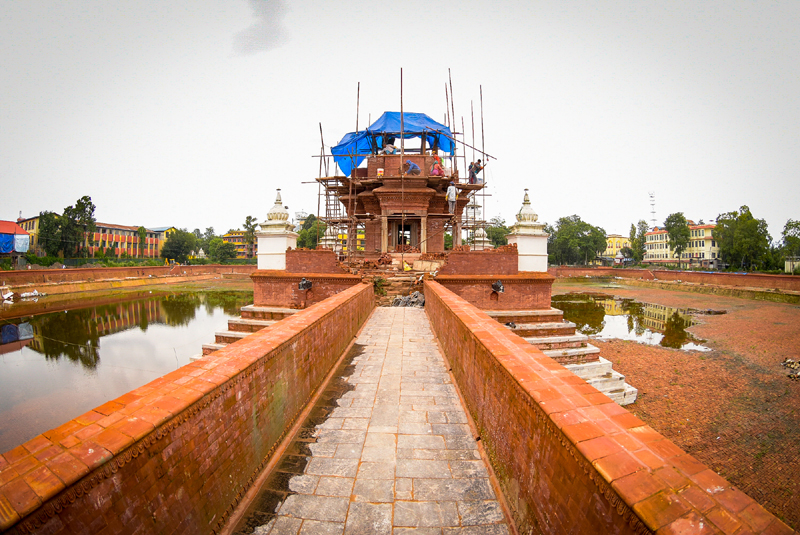Restoration of historical Ranipokhari almost completed
This is an example of how archaeologically important sites should be built
KATHMANDU, SEPTEMBER 19
After nearly five-and-a-halfyears of desiccation followed by the 2015 earthquakes that destroyed the Balgopaleshwor temple in the middle of the pond, the authorities are very close to completing replenishing the historical Ranipokhari.
Water from Bagmati River in Sundarijal was used to fill up Ranipokhari. The process is expected to be completed by 4:00pm tomorrow. The Ministry of Water Supply used the old drinking water pipeline to bring water from Sundarijal to Panipokari. From Panipokhari, the new pipeline meant for distributing water from the Melamchi River was used to fill the pond.
The 163 metres by 126 metres pond is being filled up to a height of 5.2 feet.
After Ranipokhari is replenished, it will hold almost 30 million litres of water.
The pond already had 10 million litres water from the last monsoon and a few underground borings. These borings were, however, closed after activists demanded measures to conserve underground water. The authorities now have in place a facility for recharging the pond with rainwater collected from the roofs of Trichandra College in the east, Durbar High school in the west and Biswojyoti complex in the north.
Raju Man Manandhar, an expert hired by National Reconstruction Authority, said, they also had a plan to refill the pond with water collected from Jamal area in the monsoon if the pond did not automatically start refilling.
Ranipokhar became a symbol of reconstruction modality adopted by the government for archaeologically important sites after the earthquake.
Locals and heritage activists first objected to Kathmandu Metropolitan City’s proposal to turn Ranipokhari into a recreational pond and to reconstruct it with modern construction materials.
Locals and activists had demanded that Ranipokhari be reconstructed in compliance with archaeological principles to protect its value.
By then, the local government had already dried the pond up using multilevel water pumping machines for several days. KMC had also hired contractors and used concrete after removing the archaeologically important embankment dating to the mid-seventeenth century.
This led to cultural awareness among people, who also demanded reconstruction of Balgopaleshwor temple in the Granthakut model.
Balgopaleshwor temple and the pond around it was built by King Pratap Malla in 1670, in the Granthakut style.
However, the original temple was destroyed in the 1934 earthquake. The Rana rulers of the time had then rebuilt the temple in Gumbaz style.
After years of dispute and breaching over a dozen deadlines, authorities finally agreed to reconstruct the pond following the archaeological principles of the Malla era.
Similarly, the reconstruction authority changed from KMC to the Department of Archaeology and finally went into the hands of the National Reconstruction Authority.
The NRA, in around over one year, has almost completed the reconstruction at a cost of Rs 26 million through involvement of the community.
Manandhar, the expert hired by the NRA for reconstruction, said, “Ranipokhari has become a symbol of how archaeologically important monuments need to be rebuilt.”
A version of this article appears in e-paper on September 20, 2020, of The Himalayan Times.






